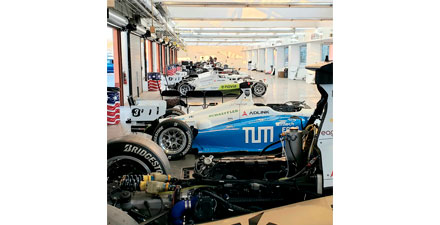
How has the cars’ technology evolved to meet the new challenges? Does IAC set specs?
The cars are all identical. The race car itself is built by Dallara, which is an Italian race car manufacturer, and it’s based on the Indy Lights chassis. Indy Lights is the theater series to INDYCAR. Indy Autonomous Challenge integrates those cars and converts them to be autonomous by installing hardware and software on the vehicles. Then our university teams develop the code and the software that essentially function as the robot driver.
The hardware, software and some technology services are all donated to us by partners that are industry leaders such as Luminar, Continental, Bridgestone, DSpace, AWS (Amazon Web Services) and Cisco. Part of our mission is to validate the technology for these industry partners.
Between the last race we ran at CES and this race, [with a bigger turbocharger] we boosted the top speed of the cars. We now set an autonomous land speed record of 192.2 MPH — that was set April 28, 2022, at the Kennedy Space Center. And we also added a new central computer from DSpace, [as well as] some additional GPS technology from a company called VectorNav, and made some other improvements and upgrades to the systems, which we believe will allow these cars to race better. By the way, we also hold the records for the fastest lap, the fastest overtake, and all racing records for autonomous vehicles. At CES 2023 we will announce additional changes that will be made to the cars and additional sponsors who will join and provide technology for the cars.
The goal is that the technology on the cars evolves constantly, every year, to feature the absolute cutting edge, really the bleeding edge, of autonomous technology.
Will the self-driving tech in these race cars ever cross over to ordinary vehicles?
They are different challenges. The way in which sensor fusion works in a low-speed scenario is, a lot of information must be taken in, because there’s a lot of uncertainty as to what happens. You’ve got to look for the lights, you’ve got to look for the turn signals, look for people, and detect and determine whether that’s a baby crossing the street or a ball bouncing, and so on. But you do that in an environment where you have some level of time to make decisions.
When you move to speeds in excess of 80, 100, 120 MPH, your ability to make decisions and the need for the sensor fusion, and the incredibly low latency that’s required to track a vehicle that’s coming at you or behind you, observe it and make a decision on which direction to move — without knowing what that other autonomous vehicle is going to do — is something that, quite honestly, has not been done by industry. The very first time it’s been proven out as even a concept is through the Indy Autonomous Challenge. We set the technical competition around those concepts the industry was not capable of doing yet, but which academia had been seeking to validate in the real world.
The focus we have on high-speed automation directly aligns with the need to improve highway safety while also opening the potential that vehicles, over time, will travel on highways at speeds that human drivers might not feel comfortable at, or even be competent to drive at based on their skills. We can begin to move freight, perhaps people but certainly freight initially, at speeds in excess of 100 MPH, maybe in excess of 120 MPH or 150 MPH, safely on highways in the future because of this type of technology. And doing that would allow goods and services, the supply chain and people’s travel time to improve dramatically in terms of speed and logistics.
For the auto industry, we offer two real value propositions. First is a proving ground for hardware and software to operate under these extreme challenging conditions or edge cases. Second is a pipeline for world class talent. The people who participate on our teams are largely PhD students at the most elite engineering universities in the world — MIT, Carnegie Mellon, Technical University of Munich, for example — and they’re largely AI roboticists, machine learning data scientists. They are not inherently automotive. In fact, if you ask some of our team members, several don’t own a car and have never driven. And now, maybe, they’re going to spend their careers working on autonomous mobility.
What role does IAC’s alliance with CTA and a race during CES play in all of this?
CES is the perfect partner and venue for Indy Autonomous Challenge. The audience fully understands and appreciates the technology and the challenges of what we’re doing. The interest that our teams have, and that our sponsors have, in showcasing this technology at a world class event like CES is terrific. Many of our sponsors are major exhibitors at CES already. There’s also an international component to CES, and the companies and the governments of countries [from which] we have teams coming are present at CES. Those are just a few reasons the partnership with CES has been incredible, in addition to the fact that you have so much tech media and industry media present and interested in what we’re doing.
Certainly, this week’s IAC race won’t be the last. How will IAC itself evolve?
After the race at Las Vegas Motor Speedway during CES 2023, we will transition to closed track road courses, through this year and into 2024. We may continue to run on ovals, but we will have demonstrated high-speed passing and maneuvering around ovals. We want to showcase what can be done at very high speeds on road courses that mimic the kinds of turns and lane changes, [for instance], that you would find on highways.